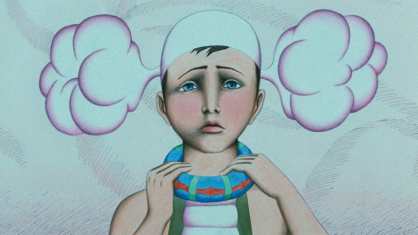The science fiction film genre offers so much potential. It’s too bad that it’s so easy to screw up (see this recent review). But then, you have movies like The Man Who Fell to Earth, something I once called “the last of the great sci-fi revolution.” Then, of course, there’s 2001: A Space Odyssey, a film I wrote my MA thesis on. It is among those inventive, quality movies that the 1973 animated film Fantastic Planet (La planète sauvage) stands. Now this film directed by René Laloux has been restored for 4K theatrical presentation, and it’s coming to our South Florida area thanks to the Miami Beach Cinematheque.
From the inventiveness of alien life on other planets to its allegory against authoritarianism to its inventive graphics and its psychedelic and often groovy soundtrack by Alain Goraguer, there is much that marvels in Fantastic Planet. Most definitive, is the imagery, designed by Roland Topor and given life by a group of Prague-based Czechoslovak animators. The animation is spare, as the characters move minimally, in a stop motion style. But that is compensated by rich, evocative illustrations, active editing and Goraguer’s relentless score featuring fat, warm bass lines and sighing female vocals. Above all, the film’s design constantly offers fascinating images, from the sinister blue giants called Draags, who seem to unravel during meditation sessions in a marvelously edited series of dissolves to the landscapes rich in oddly behaving flora and fauna, like a creature in a cage-like tree that uses a tentacled nose to snag flying lizards, shaking them before chucking them, lifeless, to the ground with a self-amused cackle.
This world, called Ygam, is a merciless place. The Draags rule the planet. Though hominid in form, they have red, lidless eyes and webbed ears. The real humans are Oms, a play on the French word hommes, which translates to “men.” If there were an equivalent of Earthly men to animals, the Oms could be seen as small lizards. Young Draags sometimes keep Oms as pets or toy with them in the wild in sadistic games. Fantastic Planet‘s plot begins when a young Draag named Tiwa decides to take an infant Om home as a pet after one such fatal game leaves him orphaned. She names him Terr (another French play on words, this time an abbreviated stand-in for Terre or Earth). Terr is also the film’s narrator as an adult.
Draags are keen on knowledge, meditation and council meetings. Oms, on the other hand, are pests who dwell in parks or in the wild, living in organized tribes that are routinely exterminated to control the population via “de-Oming” machines. When Tiwa decides to cuddle her pet Om during knowledge sessions with her telepathic headset, a new world is opened for this little Om, unbeknownst to Tiwa. Her father protests his daughter’s seemingly trivial decision. But the Om begins to gain a sort of encyclopedic knowledge of the world of Ygam.
After Terr learns how to use his owner’s headset on his own, he flees into the wild with it where he encounters tribes of free but savage Oms. Though they have crafty ways of survival, it’s often fraught with dangerous encounters with much of the planet’s quirks, from man-eating boxes to flying Om-eating monsters, not to mention, those efficient de-oming machines. But Terr’s knowledge allows for a path to emancipation.
This co-production between France and Czechoslovakia, which won the a Special Grand Prize at the Cannes Film Festival where it debuted in competition, became known as a parable for the oppression of Czechoslovakia under communist authoritarian rule. Thus, beyond all its weirdness, rich quirks of alien design and unsettling images, Fantastic Planet stands as powerful allegory. This is the strength of well-made sci-fi. By embracing the wide possibilities of the genre, a science fiction film can bring to light a powerful outcry that’s true to the current state of society. Like the best art, it’s about rearranging what society takes for granted into something we can understand anew and see as vital.
Fantastic Planet runs 72 minutes is in French with English subtitles and was rated R upon release (but MBC says its appropriate for adults and mature children, though I heard stories from people who saw it too young and were haunted by it, yet still love it as adults, nonetheless). All images used in this post courtesy Janus Films.













Glad to hear that this strange and beautiful (and, like you said, relevant) film is making the rounds again. Would be great to see it in a theater again like I did when I was 16. For those who can’t, “Fantastic Planet” is also available as a Criterion Collection DVD, which I picked up recently.
Yes! Janus is affiliated with Criterion, so that is probably why it’s making the theater rounds.